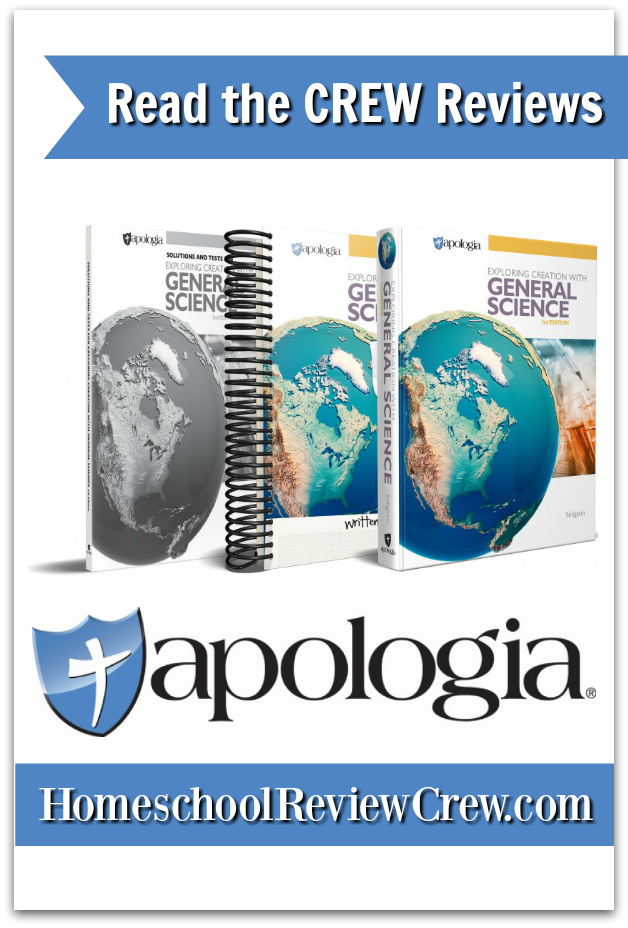Some links which follow may be affiliate ones.
Apologia generously sent me the Textbook, Student Notebook, and Solutions and Test Manual for review, and, I have to say, this homeschool science for middle school program is one I am glad to have on hand
A Well-Designed Textbook
The Exploring Creation with General Science, 3rd Edition Textbook goes both broad and deep.
It is a 400+ page hardcover book written in a conversational style that goes broad in that it covers a wide range of topics over 14 modules, including Astronomy, Geology and Paleontology, Meteorology and Oceanography, Chemistry, Physics, Life Science, Biology, Marine Science, and Environmental Science.
It goes deep in that it covers the History of Science, Scientific Inquiry, the Scientific Method, Documenting and Interpreting Experimental Results, Scientific Analysis, and Science and Creation, all while encouraging independent study, mastery of knowledge of contemporary scientific concepts, and the grounding necessary to transition to high school science and continue on with a lifelong passion for exploring God’s creation.
The author of the course has this to say about its design and big ideas:
Within each of the 14 modules in the Textbook, there are several related topics covered, experiments and activities, study guide questions, and more.
Modules are designed to take about 2 1/2 weeks with a 4 day schedule of 45 minute class periods, which adds up to a 33 week course with plenty of wiggle room for those busy weeks when you might need to flex.
Each module is easy to locate with color coded tabs and top margins in the text.
Text words in blue boldface offer definitions to memorize and those in black boldface signal important terms to comprehend.
Right from the beginning of the Textbook, there are also several “What To Do” instructions that guide you with notetaking, experiments, and to filling out your lab reports.
“On Your Own” questions help you to see if you are understanding and retaining the information. Answers for these can be checked at the end of modules, so you can easily see what you might want to go back to study again.
Activities come in two types: “Experiments” and “Explore More”. These are clearly marked and explained.
Experiments are concise and described in an easy-to-follow way. They can be completed with things that you likely already have or you can obtain at your local grocery, pharmacy, or hardware store without trouble. (A complete list of supplies is broken down by module and experiment in the back of the book.)
The “Explore More” are quick, appealing, hands-on activities help you better understand concepts you’re learning.
The entire book is visually appealing with helpful color coding, a decent amount of white space, short paragraphs, plenty of photos and graphics, etc.
A Lay-Flat and Super Helpful Student Notebook
The Student Notebook is a 540+ page, full-color, spiral-bound, consumable resource that helps you truly get the most out of the course.
- a colored box called “What To Do” at the beginning of each lesson which tells you all the information needed to complete that day’s lesson.
- areas for notetaking.
- prompts.
- tables and infographics.
- “Creation Connections” sections which encourage you to freely express your thoughts on how you view the world in relation to what you are learning and how what you are learning applies to their everyday life.
- material lists for experiments.
and more.
At the end of Student Notebook, there is also a lab report checklist and grading rubric.
Easy-to-Use Testing Materials
Easy-to-Use Testing Materials
The Solutions and Test Manual contain blank copies of tests and copies with solutions on them for all modules except the Science and Creation one.
These are separately bound so there is no temptation for students with a test booklet to look ahead at answers (not that any would 😉) and the first two module tests suggest that you take them in an open-book test method with access to the Textbook and Student Notebook.
Tests are fairly brief and include fill-in, multiple choice, matching, and short answer questions.
In my opinion, an additional notebook for writing out your answers is necessary for the short answer portions, but, otherwise, the tests are open-and-go.
Tests are fairly brief and include fill-in, multiple choice, matching, and short answer questions.
In my opinion, an additional notebook for writing out your answers is necessary for the short answer portions, but, otherwise, the tests are open-and-go.
Final Thoughts
In addition to the materials I have already described, there is also an MP3 Audio CD and/or the Video Instruction Thumb Drive available to go with Exploring Creation with General Science, 3rd Edition Textbook, which, unfortunately for me and mine, we were not able to get yet.
However, I have used the CD’s with past Apologia curriculum and can attest they are usually very well done and hugely helpful for my family which is often on the road and includes one child with reading challenges. In fact, for me and mine, the audio book is typically an essential part of the program that makes it flexible, accessible, and just what we can use.
That said, truly each of the program components is well-designed and can help get you working independently, diving into science, doing experiments, etc. with proficiency, passion, and a Christian worldview. For these reasons, I recommend A Exploring Creation with General Science, 3rd Edition Textbook to anyone with a middle school level student that is ready to take the next steps in science learning and discovery!
Learn More
If you'd like a larger taste of what the program has to offer, click to view a SAMPLE.
To learn more about Apologia, connect on Social Media:
You can also see what 39 other reviewers thought about Exploring Creation with General Science, 3rd Edition Textbook clicking through to all the Homeschool Crew reviews.
You can also view all our prior Apologia reviews.


















